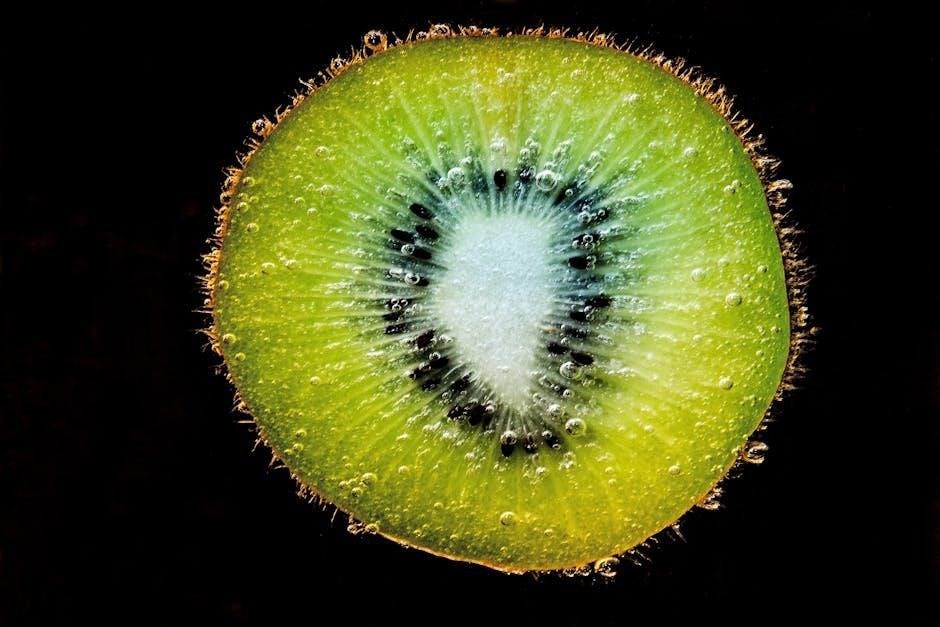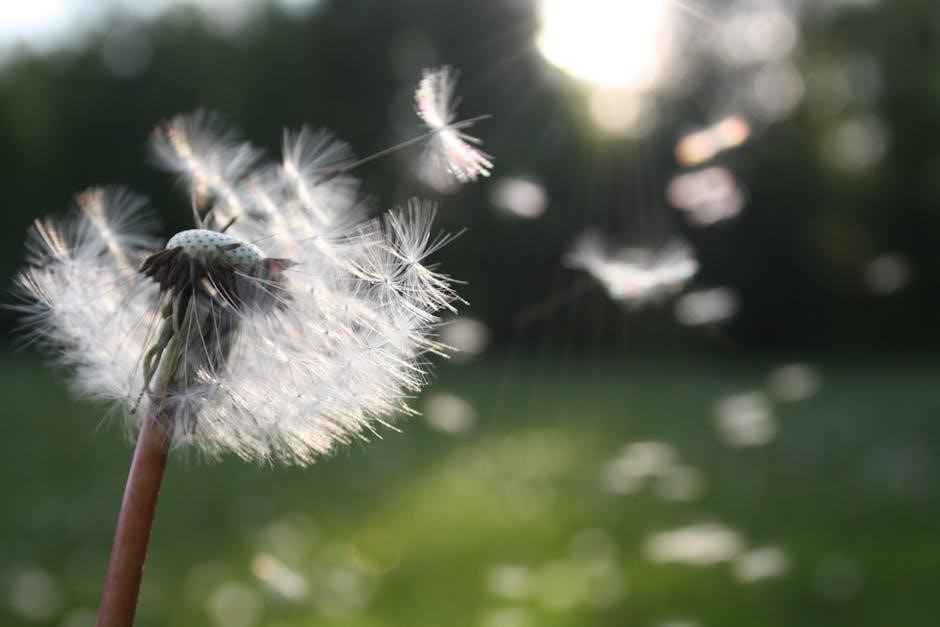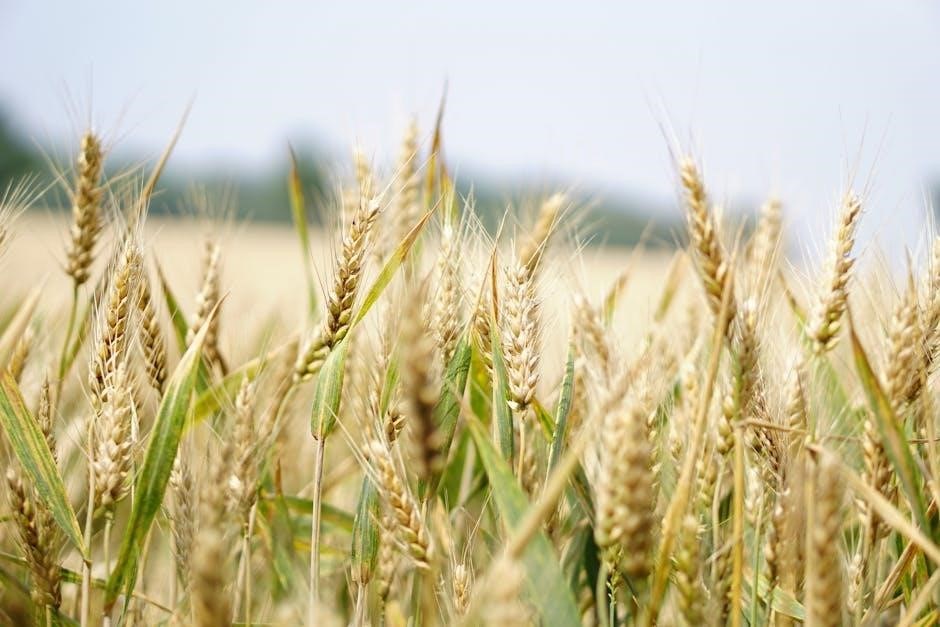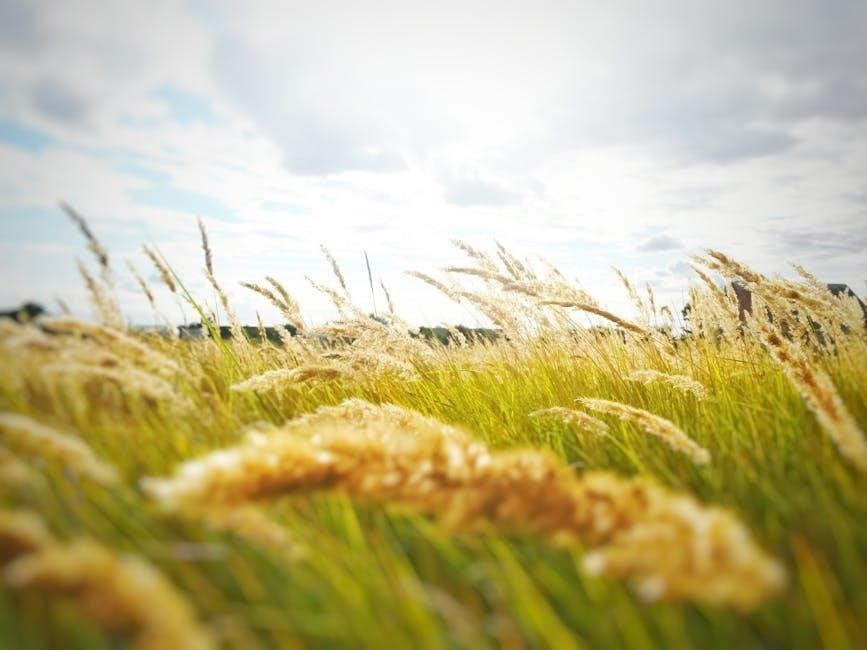Overview of “From Seed to Plant” by Gail Gibbons
Gail Gibbons’ “From Seed to Plant” unveils the fascinating journey of seeds transforming into plants. Gibbons, a nonfiction master, uses simple language and bright illustrations. The book explores pollination and germination.
Embark on an exploration of the seed’s incredible journey, as detailed in Gail Gibbons’ “From Seed to Plant.” This section delves into the very essence of what a seed is and its potential for life. Discover how these tiny packages hold the blueprint for future plants, containing all the necessary components for growth and development. From the outer protective layer to the embryo within, each part plays a crucial role in the seed’s survival and eventual transformation. The book highlights the different types of seeds and their unique characteristics, showcasing the diversity found in nature. Learn about the conditions that seeds need to germinate, such as water, warmth, and sunlight, and how they interact with their environment to initiate the growth process. Gibbons’ clear and concise explanations, coupled with vibrant illustrations, make this complex topic accessible to young readers. The section emphasizes the importance of seeds as the starting point for plant life, laying the foundation for understanding the subsequent stages of growth. Through engaging visuals and informative text, “From Seed to Plant” sparks curiosity and fosters a deeper appreciation for the natural world.

Pollination Explained in “From Seed to Plant”
Gail Gibbons expertly elucidates the process of pollination in her book “From Seed to Plant,” making it understandable for young readers. Pollination, the crucial step in the reproduction of flowering plants, is broken down into its fundamental components. The book explains how pollen grains, the male reproductive cells, are transferred from the stamen (the male part of the flower) to the pistil (the female part of the flower). Gibbons illustrates the various methods of pollination, including wind pollination, where pollen is carried by the wind to other flowers, and animal pollination, where insects, birds, or other animals transfer pollen as they move from flower to flower. The role of bees, butterflies, and other pollinators is highlighted, emphasizing their importance in the ecosystem. The book also touches upon self-pollination, where a flower can pollinate itself. Through clear diagrams and simple explanations, Gibbons demystifies this complex biological process, revealing the intricate relationship between plants and their pollinators. The section underscores the significance of pollination for seed formation and the continuation of plant life. By presenting pollination in an accessible and engaging manner, “From Seed to Plant” fosters a greater understanding of the natural world and the interconnectedness of living organisms.
Germination: The Start of New Life
In “From Seed to Plant,” Gail Gibbons dedicates a significant portion to explaining germination, the remarkable process by which a seed begins to grow and develop into a new plant. Germination is presented as the exciting start of a plant’s life cycle, where a seemingly dormant seed awakens and embarks on its journey to become a fully grown organism. Gibbons meticulously details the conditions necessary for germination to occur, emphasizing the importance of water, warmth, and oxygen. Water is essential for hydrating the seed and activating the enzymes needed for growth. Warmth provides the optimal temperature for metabolic processes to begin, while oxygen is required for cellular respiration, which fuels the seed’s development. The book illustrates how the seed’s outer coat, or seed coat, protects the embryo inside until the conditions are right for germination. Once these conditions are met, the seed coat cracks open, and the radicle, or embryonic root, emerges first, anchoring the plant and absorbing water and nutrients from the soil. Following the radicle, the plumule, or embryonic shoot, emerges, reaching towards the sunlight. Gibbons’ illustrations vividly depict this process, showing the gradual development of the seedling as it grows taller and stronger. The section on germination highlights the resilience and potential hidden within each seed, offering young readers a sense of wonder and appreciation for the natural world. Through clear explanations and engaging visuals, “From Seed to Plant” makes the complex process of germination accessible and captivating for children.
Planting a Garden: Practical Tips from the Book
Gail Gibbons’ “From Seed to Plant” doesn’t just explain the science behind plant growth; it also provides practical advice on how young readers can start their own gardens. The book offers simple, step-by-step instructions that make gardening accessible and enjoyable for children. Gibbons emphasizes the importance of choosing the right seeds for your garden, suggesting options like beans or sunflowers that are easy to grow and provide quick results. She also highlights the need for good soil, explaining how it provides essential nutrients and support for the growing plants. The book advises readers to select a sunny spot for their garden, as sunlight is crucial for photosynthesis, the process by which plants convert light energy into food. Gibbons guides children through the process of preparing the soil, showing them how to loosen it and remove any weeds or rocks that could hinder growth. She then explains how to plant the seeds, emphasizing the importance of spacing them properly and covering them with the right amount of soil. Watering is another key aspect of gardening that Gibbons addresses, advising readers to keep the soil moist but not waterlogged. The book also touches on the importance of patience, reminding young gardeners that it takes time for seeds to germinate and grow into mature plants. Throughout this section, Gibbons’ illustrations provide visual guidance, showing children exactly what to do at each step. By offering these practical tips, “From Seed to Plant” empowers children to engage in hands-on learning and experience the satisfaction of growing their own food and flowers. The book transforms gardening from a daunting task into a fun and rewarding activity.

Activities Related to “From Seed to Plant”
“From Seed to Plant” inspires numerous educational activities. These include literacy exercises like seed journal creation and science experiments such as growing bean plants. These hands-on projects reinforce learning.
Literacy Activities
Following “From Seed to Plant” by Gail Gibbons, several literacy-based activities can enhance comprehension and engagement. One effective activity involves creating a “How to Grow a Bean” guide, where students use scissors, glue, and the book as a reference to illustrate and describe the steps of planting a bean. This combines reading comprehension with practical application, reinforcing the life cycle of a plant in a tangible way.
Another engaging activity is the “Seed Journal,” where students maintain a daily or weekly log of their own planted seeds. This journal includes drawings, observations, and written descriptions of the seed’s progress as it germinates and grows. This activity encourages observational skills, vocabulary development related to plant growth, and the practice of recording scientific data. Students can track changes in the seed’s appearance, the emergence of sprouts, and the development of leaves, fostering a deeper understanding of the plant’s life cycle.
To further integrate literacy, consider using vocabulary cards featuring key terms from the book, such as “pollination,” “germination,” “seed,” and “roots.” These cards can be used in various activities, including matching games, sentence building exercises, and class discussions. A “Think, Triad, Share” chart can also be implemented to encourage collaborative learning, where students discuss their understanding of the book in small groups before sharing their insights with the class. This promotes critical thinking, communication skills, and a deeper exploration of the concepts presented in “From Seed to Plant.”
Science Activities
After reading “From Seed to Plant” by Gail Gibbons, a range of science activities can solidify understanding of plant biology. One hands-on activity involves dissecting different types of seeds, such as beans, peas, or corn kernels. Students can carefully examine the seed’s parts, including the seed coat, embryo, and cotyledons, using magnifying glasses to observe the structures in detail. This activity allows students to visualize the components of a seed and understand their roles in germination and early plant development. They can also compare and contrast different seed types, noting variations in size, shape, and internal structures.
Another engaging science activity is a plant growth experiment. Students can plant seeds in clear plastic cups or containers filled with soil, providing them with water and sunlight. They can then observe and record the germination process, noting the time it takes for the seed to sprout and the initial growth of the seedling. Students can manipulate variables such as the amount of water, sunlight exposure, or soil type to investigate their effects on plant growth. This experiment fosters scientific inquiry, data collection, and analysis skills, as students track the plant’s progress over time and draw conclusions about the factors that influence its development.
To further explore the concepts of pollination and seed dispersal, students can conduct a simulation activity. They can use cotton swabs or brushes to transfer “pollen” (represented by colored powder or glitter) from one flower to another, demonstrating the process of pollination. They can also investigate different methods of seed dispersal, such as wind dispersal by creating paper airplanes with attached “seeds” (paper clips) or animal dispersal by attaching “seeds” (small objects) to socks and walking around to see where they fall off. These activities enhance understanding of plant reproduction and the importance of seed dispersal for plant survival.

Vocabulary Cards and Learning Charts
To enhance comprehension and retention of key concepts from Gail Gibbons’ “From Seed to Plant,” vocabulary cards and learning charts serve as invaluable educational tools. Vocabulary cards can be created for essential terms such as “pollination,” “germination,” “seed coat,” “embryo,” “cotyledon,” “stamen,” “pistil,” and “ovary.” Each card should feature the vocabulary word prominently displayed on one side, accompanied by a clear and concise definition or explanation on the reverse side. Visual aids, such as illustrations or diagrams, can further enhance understanding and memory recall. These cards can be used for individual study, paired activities, or group review sessions, fostering vocabulary acquisition and reinforcing understanding of plant anatomy and processes.
Learning charts provide a visual framework for organizing and presenting information from the book in a structured and accessible manner. A “Life Cycle of a Plant” chart can illustrate the stages of plant development, from seed germination to mature plant with flowers and seeds. Each stage can be depicted with corresponding images and brief descriptions, highlighting the key events and transformations that occur. Another useful chart is a “Parts of a Flower” diagram, which labels the different flower structures, such as petals, sepals, stamen, pistil, and ovary, explaining their respective functions in pollination and fertilization. These charts can be displayed in the classroom as reference tools, promoting visual learning and reinforcing understanding of plant biology concepts.
Additionally, interactive learning charts can be created to engage students actively in the learning process. For example, a “Pollination Process” chart can feature movable pieces representing pollen grains, insects, or wind, allowing students to simulate the transfer of pollen from the stamen to the pistil. A “Seed Dispersal Methods” chart can showcase different strategies employed by plants for seed dispersal, such as wind dispersal, water dispersal, animal dispersal, and explosive dispersal, with corresponding images and examples. These interactive charts promote hands-on learning and encourage students to explore and experiment with plant biology concepts, fostering deeper understanding and engagement.
The Importance of Plants: As Highlighted by Gibbons
Gail Gibbons’ “From Seed to Plant” subtly yet powerfully underscores the vital role plants play in sustaining life on Earth. The book, through its clear explanations and vibrant illustrations, reveals how plants are not merely decorative elements in our environment but are fundamental to our survival and well-being. Gibbons highlights several key aspects of plant importance, emphasizing their contribution to the ecosystem and their direct impact on human lives.
Firstly, the book implicitly showcases plants as the primary producers in the food chain. By detailing the process of seed germination and plant growth, Gibbons illustrates how plants convert sunlight into energy through photosynthesis, creating the foundation for all terrestrial food webs. Plants provide nourishment for a vast array of organisms, from insects and herbivores to humans, making them indispensable for sustaining life. The book’s focus on how seeds develop into edible plants, like fruits and vegetables, further reinforces this idea.
Secondly, “From Seed to Plant” emphasizes the role of plants in maintaining a healthy atmosphere. While not explicitly stated, the book’s depiction of plant growth implies the crucial process of carbon dioxide absorption and oxygen release. Plants absorb carbon dioxide from the atmosphere during photosynthesis, helping to mitigate climate change and regulate global temperatures. Simultaneously, they release oxygen, which is essential for the respiration of animals and humans. This vital function of plants is subtly conveyed through the book’s illustrations of lush green foliage and thriving plant life.
Thirdly, Gibbons’ book implicitly touches upon the economic and cultural significance of plants. Throughout history, plants have been utilized for a multitude of purposes, including food, medicine, clothing, shelter, and fuel. Many cultures have developed deep-rooted traditions and practices centered around plants, recognizing their spiritual and medicinal properties. While “From Seed to Plant” primarily focuses on the biological aspects of plant growth, it implicitly acknowledges the broader importance of plants in human society and culture.

Gail Gibbons’ Style and Approach
Gail Gibbons is celebrated for her distinctive style and approach to nonfiction writing, particularly in children’s literature. Her work, exemplified by “From Seed to Plant,” is characterized by its clarity, accessibility, and engaging presentation of complex topics. Gibbons possesses a remarkable ability to distill intricate scientific processes into easily understandable concepts for young readers, fostering a love for learning and exploration. Several key elements define her signature style.
Firstly, Gibbons employs simple and direct language, avoiding technical jargon and complex sentence structures. She carefully selects vocabulary that is appropriate for her target audience, typically elementary-aged children, ensuring that the information is readily accessible and comprehensible. This approach allows young readers to grasp the fundamental concepts without being overwhelmed by scientific terminology. In “From Seed to Plant,” Gibbons explains the processes of pollination, germination, and plant growth using clear and concise language, making it easy for children to follow along.
Secondly, Gibbons’ illustrations play a crucial role in enhancing understanding and engagement. Her artwork is characterized by its bright colors, detailed depictions, and clear labeling. The illustrations in “From Seed to Plant” complement the text, providing visual representations of the various stages of plant growth, the different parts of a flower, and the process of pollination. These visual aids help children to visualize the concepts being explained and to reinforce their understanding. Gibbons’ illustrations are not merely decorative; they are integral to the learning process.
Thirdly, Gibbons’ approach is characterized by its focus on accuracy and detail. She meticulously researches her subjects, ensuring that the information presented is accurate and up-to-date. While simplifying complex concepts, she avoids oversimplification, maintaining the integrity of the scientific information. This commitment to accuracy instills confidence in readers and encourages them to view Gibbons’ books as reliable sources of information. The detailed diagrams and labeled illustrations in “From Seed to Plant” demonstrate her dedication to providing accurate and informative content.
